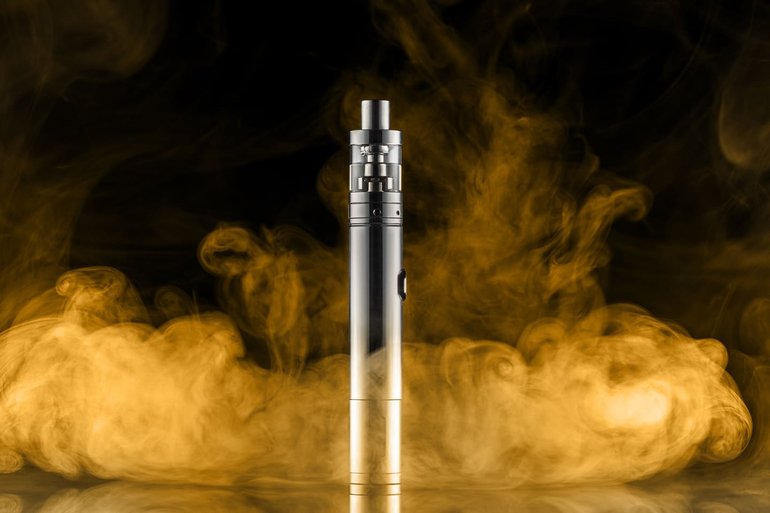


15 Oct 25
As more and more people are aware of the dangers of cigarette smoke, vaping is becoming an increasingly popular alternative for those who wish to quit the habit or just keep indulging in those familiar gestures but without the smell and toxicity of smoke. But is vaping safe – or at least as safe as people believe it to be – for our bodies?
In this article, we will examine how e-cigarettes work and the effects of vaping on our respiratory health. In order not to lose focus, we will only consider electronic cigarettes that use e-liquid, while heated tobacco products will not be analyzed as they deserve a separate dissertation.
Electronic cigarettes – commonly known as e-cigarettes or e-cigs – are devices usually made of 4 different components: a battery, an atomizer, an e-liquid tank, and a mouthpiece.
The atomizer is the core of the e-cigarette technology: it heats the aromatic liquid inside and turns it into a mist that can be inhaled via the mouthpiece like an aerosol, with no need for combustion.
This means no fire and ashes, leading to a consistent drop in harmful chemicals like carbon monoxide or hydrogen cyanide.
The aromatic liquids used in vaping are commonly called e-liquids or e-juices. E-liquid composition may vary according to the vaping habits of the consumer, but they are mostly made of:
Let’s move to the heart of the problem: Is vaping safe, or are there risks consumers fail to see?
Indeed, the absence of combustion means the toxic chemicals inhaled are greatly reduced. Thus said, the vapor inhaled is not water vapor and is definitely not clean air, meaning there are still risks for your respiratory system.
Besides that, since vaping is a relatively new habit, long-term effects are still being studied.
Among the substances commonly used in vaping, nicotine is the most problematic. The European Scientific Committee on Health, Environmental and Emerging Risks (SCHEER) finds weak evidence that vaping helps people quit nicotine addiction, especially in consumers who keep using traditional cigarettes alongside vaping.
On top of that, according to SHEER, there is moderate evidence that e-cigarettes are a gateway to smoking for youth and strong evidence that flavorings increase their appeal, raising the risk threshold for younger people.
Propylene glycol and glycerol are, technically speaking, FDA-approved and are largely used in the food and cosmetic industry. However, although they are considered safe to eat, inhalation is a whole different story.
Vaporized e-liquid may be free of carbon dioxide and heavy metals, but toxic compounds such as diacetyl and acetaldehyde are still formed during the heating of e-juices.
Studies are starting to show that e-cigarette consumption may cause airway irritation, coughing, and shortness of breath, and has been linked to the worsening of asthma attacks.
Concerns are also arising around a newly observed condition named EVALI, as well as popcorn lung.
EVALI (E-cigarette or Vaping product use-Associated Lung Injury) is an umbrella term for several issues that are linked to vaping.
Common symptoms of EVALI include:
Being a relatively new condition, it is still unclear whether EVALI can be cured or not. The diagnosis itself may be complex and relies mostly on the identification of pulmonary infiltrates via imaging tests like CT scans or chest x-rays once more common causes, like COVID-19 or flu, have been ruled out.
Bronchiolitis obliterans, also known as popcorn lung, went from being some sort of urban legend to a tangible risk once vaping got so popular.
Originally diagnosed in the early 2000s among workers in a microwave popcorn factory – hence the name – it consists of an irreversible condition that causes scarring of the tiny air sacs in the lungs and leads to wheezing and shortness of breath.
The cause of the condition, at the time, was identified in the inhalation of diacetyl, a buttery-flavored chemical commonly used in certain products.
After the manufacturer removed diacetyl from their products, the incidence of popcorn lung suddenly dropped, but, as vaping became more and more popular, healthcare professionals started to worry about the inhalation of diacetyl and acetaldehyde, and, apparently, they were not wrong.
Brianne Cullen, a 17-year-old from Nevada, was diagnosed with bronchiolitis obliterans early in 2025, after secretly vaping for years, and her case is raising concerns about the effects of vaping on respiratory health, especially among the young.
Although e-cigarettes may reduce exposure to a number of toxic substances and compounds, if compared to combustible cigarettes, it is not advisable to consider them absolutely safe, as they may cause airway inflammation and promote nicotine addiction. Moreover, the long-term effects of vaping are still unclear.
For these reasons, major health agencies such as the WHO, CDC, or SHEER recommend avoiding the use of e-cigarettes, especially by non-smokers, youth, and pregnant women, and encourage the use of proven methods to quit smoking.
